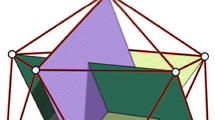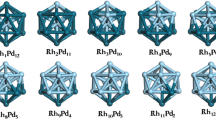Abstract:
The icosahedral to cuboctahedral structural transition in RhN and PdN clusters with closed atomic shells and increasing sizes (N=13, 55, 147, 309, 561) is studied using a tight-binding description of the valence band including sp electrons as well as d electrons assuming an homogeneous relaxation, the effect of inhomogeneous relaxation being discussed by means of an empirical potential. The critical size at which the cuboctahedral and icosahedral clusters have roughly the same energy is similar for Rh and Pd. The potential energy profile for the Mackay transformation which distorts continuously a cuboctahedron into an icosahedron is also calculated. The cuboctahedral structure is found to be unstable for N=13 but, for , the potential energy profile exhibits an activation barrier which is expected to persist at least in some range of larger sizes. This explains the coexistence of both geometries at intermediate sizes. Finally the electronic structure of these clusters is also discussed.
Similar content being viewed by others
Author information
Authors and Affiliations
Additional information
Received 3 November 1999
Rights and permissions
About this article
Cite this article
Barreteau, C., Desjonquères, M. & Spanjaard, D. Theoretical study of the icosahedral to cuboctahedral structural transition in Rh and Pd clusters. Eur. Phys. J. D 11, 395–402 (2000). https://doi.org/10.1007/s100530070068
Issue Date:
DOI: https://doi.org/10.1007/s100530070068




